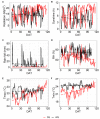Season Affects Yield and Metabolic Profiles of Rice (Oryza sativa) under High Night Temperature Stress in the Field
- PMID: 32366031
- PMCID: PMC7247591
- DOI: 10.3390/ijms21093187
Season Affects Yield and Metabolic Profiles of Rice (Oryza sativa) under High Night Temperature Stress in the Field
Abstract
Rice (Oryza sativa) is the main food source for more than 3.5 billion people in the world. Global climate change is having a strong negative effect on rice production. One of the climatic factors impacting rice yield is asymmetric warming, i.e., the stronger increase in nighttime as compared to daytime temperatures. Little is known of the metabolic responses of rice to high night temperature (HNT) in the field. Eight rice cultivars with contrasting HNT sensitivity were grown in the field during the wet (WS) and dry season (DS) in the Philippines. Plant height, 1000-grain weight and harvest index were influenced by HNT in both seasons, while total grain yield was only consistently reduced in the WS. Metabolite composition was analysed by gas chromatography-mass spectrometry (GC-MS). HNT effects were more pronounced in panicles than in flag leaves. A decreased abundance of sugar phosphates and sucrose, and a higher abundance of monosaccharides in panicles indicated impaired glycolysis and higher respiration-driven carbon losses in response to HNT in the WS. Higher amounts of alanine and cyano-alanine in panicles grown in the DS compared to in those grown in the WS point to an improved N-assimilation and more effective detoxification of cyanide, contributing to the smaller impact of HNT on grain yield in the DS.
Keywords: dry season; grain yield; high night temperature; metabolomics; rice; wet season.
Conflict of interest statement
The authors declare no conflict of interest. The funders had no role in the design of the study; in the collection, analyses, or interpretation of data; in the writing of the manuscript, or in the decision to publish the results.
Figures















Similar articles
-
Post-flowering night respiration and altered sink activity account for high night temperature-induced grain yield and quality loss in rice (Oryza sativa L.).Physiol Plant. 2017 Jan;159(1):59-73. doi: 10.1111/ppl.12485. Epub 2016 Sep 5. Physiol Plant. 2017. PMID: 27513992
-
High night temperature strongly impacts TCA cycle, amino acid and polyamine biosynthetic pathways in rice in a sensitivity-dependent manner.J Exp Bot. 2015 Oct;66(20):6385-97. doi: 10.1093/jxb/erv352. Epub 2015 Jul 23. J Exp Bot. 2015. PMID: 26208642 Free PMC article.
-
Rice yield and quality in response to daytime and nighttime temperature increase - A meta-analysis perspective.Sci Total Environ. 2023 Nov 10;898:165256. doi: 10.1016/j.scitotenv.2023.165256. Epub 2023 Jul 7. Sci Total Environ. 2023. PMID: 37423281
-
High night temperature stress on rice (Oryza sativa) - insights from phenomics to physiology. A review.Funct Plant Biol. 2024 May;51:FP24057. doi: 10.1071/FP24057. Funct Plant Biol. 2024. PMID: 38815128 Review.
-
Physiological and molecular attributes contribute to high night temperature tolerance in cereals.Plant Cell Environ. 2021 Jul;44(7):2034-2048. doi: 10.1111/pce.14055. Epub 2021 May 4. Plant Cell Environ. 2021. PMID: 33764557 Review.
Cited by
-
Climate Stressors on Growth, Yield, and Functional Biochemistry of two Brassica Species, Kale and Mustard.Life (Basel). 2022 Oct 6;12(10):1546. doi: 10.3390/life12101546. Life (Basel). 2022. PMID: 36294981 Free PMC article.
-
Genome-wide association study and gene network analyses reveal potential candidate genes for high night temperature tolerance in rice.Sci Rep. 2021 Mar 24;11(1):6747. doi: 10.1038/s41598-021-85921-z. Sci Rep. 2021. PMID: 33762605 Free PMC article.
-
Differentiation of the High Night Temperature Response in Leaf Segments of Rice Cultivars with Contrasting Tolerance.Int J Mol Sci. 2021 Sep 28;22(19):10451. doi: 10.3390/ijms221910451. Int J Mol Sci. 2021. PMID: 34638787 Free PMC article.
-
Utilizing PacBio Iso-Seq for Novel Transcript and Gene Discovery of Abiotic Stress Responses in Oryza sativa L.Int J Mol Sci. 2020 Oct 31;21(21):8148. doi: 10.3390/ijms21218148. Int J Mol Sci. 2020. PMID: 33142722 Free PMC article.
-
Role of alanine aminotransferase in crop resilience to climate change: a critical review.Physiol Mol Biol Plants. 2024 Dec;30(12):1935-1953. doi: 10.1007/s12298-024-01540-8. Epub 2024 Dec 11. Physiol Mol Biol Plants. 2024. PMID: 39744323 Free PMC article. Review.
References
-
- GRISP . Global Rice Science Partnership. International Rice Research Institute; Los Baños, Philippines: 2013.
-
- FAO. FAOSTAT Database 2009. [(accessed on 23 October 2019)]; Available online: http://faostat.fao.org/
-
- IPCC . AR5 Climate Change 2014: Impacts, Adaptation, and Vulnerability. Cambridge Univ. Press; Cambridge, UK: 2014.
-
- FAO. FAOSTAT Database 2014. [(accessed on 2 November 2019)]; Available online: http://faostat.fao.org/
-
- Easterling D.R., Horton B., Jones P.D., Peterson T.C., Karl T.R., Parker D.E., Salinger M.J., Razuvayev V., Plummer N., Jamason P., et al. Maximum and minimum temperature trends for the globe. Science. 1997;277:364–367. doi: 10.1126/science.277.5324.364. - DOI
MeSH terms
Substances
Grants and funding
LinkOut - more resources
Full Text Sources
Miscellaneous

